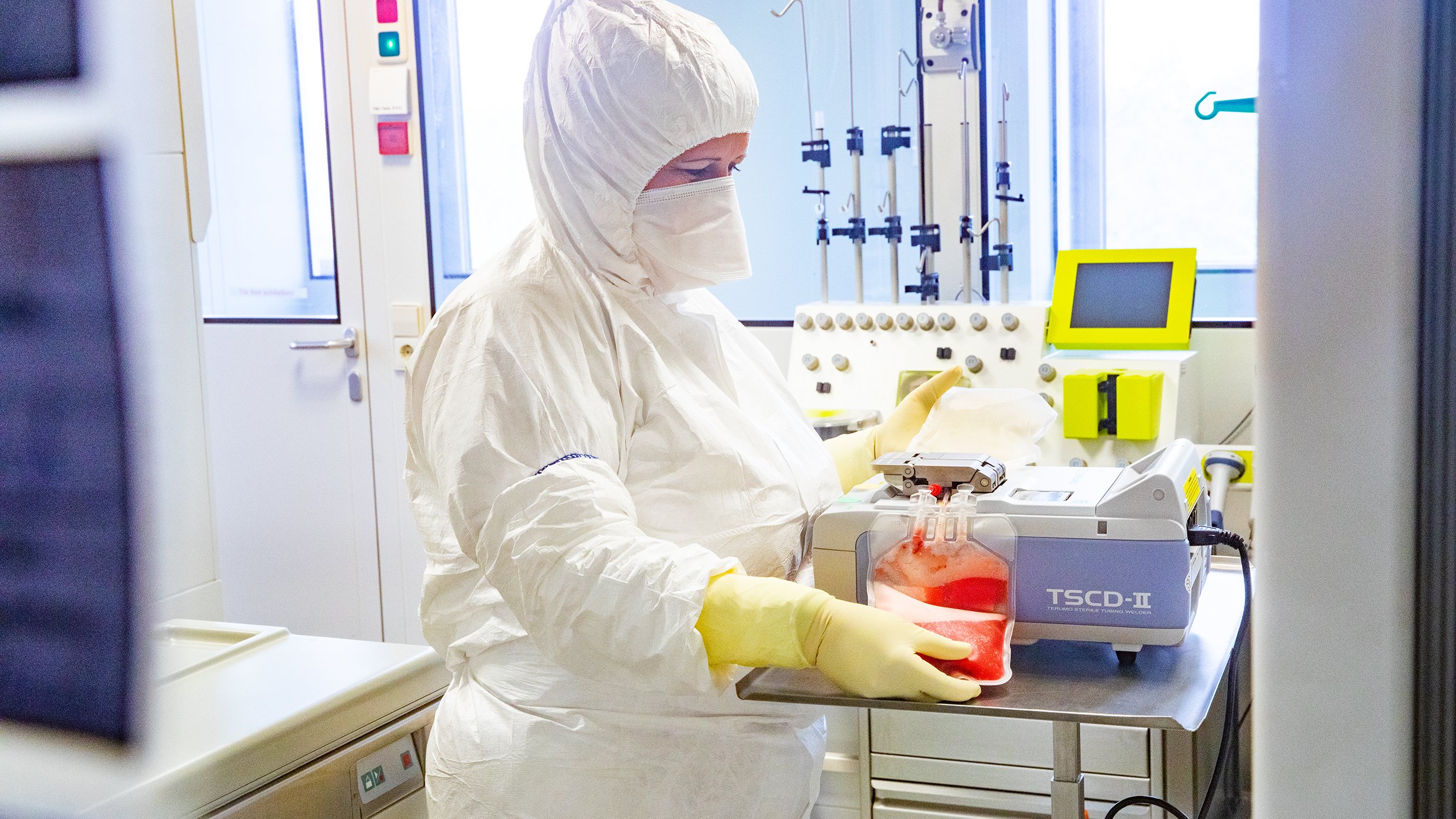The ATMP-GMPDU development unit at the Institute for Cell Therapeutics supports research groups in the development of new cellular drugs.

From development in the laboratory to production in the clean room: the Institute for Cell Therapeutics offers researchers advice and assistance in the production of new cell therapies. Copyright: Karin Kaiser/MHH
10. July 2023
Using living cells for therapy is a promising alternative when classical treatment methods fail in the fight against the most severe diseases. In addition to stem cell transplantation, therapies using genetically modified cells have now also been approved in Europe as so-called advanced therapy medicinal products. They are called Advanced Therapy Medicinal Product or ATMP for short. In order to prevent contamination with pathogens or undesirable effects, ATMPs must be manufactured under strictly controlled conditions in accordance with the high quality specifications of good manufacturing procedure (GMP) under cleanroom conditions. This is done at the MHH at the Institute for Cell Therapeutics, in the Cellular Therapy Centre (CTC) department. But the institute offers more than manufacturing and quality control. One floor below, the ATMP-GMPDU development department provides MHH research groups with its expertise and equipment to jointly realize innovative ideas for new cellular therapeutics.
Advice right from the start
"As a Core Facility, we support and advise MHH research groups on how to implement their projects for the development of new cellular drugs according to GMP specifications," says Dr. Ruth Esser, head of the Development Department. Even in the initial phase of a project, it is important to ensure that the specifications for later therapeutic application are met, the cell biologist emphasizes. This applies in particular to the use of techniques and excipients. "From the very beginning of the project, we already have the translation, the clinical application, in mind," the scientist explains. And there is a lot to consider here, because even the best research idea can fail if it does not meet the subsequent requirements of the manufacturing companies. "This sometimes affects things as banal as nutrient media or reagents that work perfectly in the laboratory but are simply not approved for the manufacture of a drug and use on patients," notes Dr. Esser. The Core Facility keeps an eye on the special requirements of potential industrial partners and is familiar with the strict regulations, manufacturing protocols and systems of the relevant authorities, such as the Trade Supervisory Office or the Paul Ehrlich Institute. As a link and translator between the scientists at the MHH and the pharmaceutical companies, it ensures that research and manufacturing go hand in hand and reduces potential inefficiencies.
Risk of contamination excluded
However, the close collaboration between the researchers and the GMPDU also has a very practical side. For certain phases of the experiment, the MHH scientists can use the so-called Clinical Scale Up Laboratory of the Core Facility, which offers them special equipment necessary for GMP-compatible work.
This includes, for example, a device that allows the automatic production of cells. In the closed system, cells can be prepared, genetically modified and propagated in several steps. "This cell processor eliminates the risk of contamination even without adding antibiotics," emphasizes Dr. Wolfgang Glienke, a research associate. Other additional devices that sterilely connect or seal tubes are also necessary to work in a GMP-compliant manner.
The research unit also has a large portfolio ready for preclinical research with cell cultures. "For example, we have developed standard procedures for the isolation, activation and propagation of T and NK cells of the human immune system, which we make available to researchers at the MHH as well as to external companies," Dr. Glienke tells us. "But of course we can also develop other cell culture models," the molecular biologist adds.
Fluorescence microscope allows long-term observation of cells
Before a newly developed cell therapy drug goes into production, it must of course be checked whether it does what it is supposed to do. This is not so easy with living cells, because they must be observed under conditions in which they can continue to live. "For visual imaging and long-term observation, we have a special fluorescence microscope with a special incubation chamber that maintains temperature, humidity and CO2 levels in the ideal range," says Dr. Glienke. It can also be used to study the interaction of different cell types and capture it in a time-lapse video. A look into the microscope, for example, shows whether human T cells such as CARs and TRUCKs, which have been genetically modified in the laboratory, actually recognize tumor cells better and attack them faster than before they were activated. Research groups at the MHH can also take advantage of this offer in collaboration with the Core Facility.
Once the preclinical development of the new cell therapeutic has been successfully completed, the process must be checked at least three more times according to fixed specifications. This is again done upstairs in the CTC's clean rooms. "Once validation is complete, the CTC applies for a manufacturing license from the relevant state authority. A decision on a clinical trial is made at the federal level by the Paul Ehrlich Institute," says Dr. Lubomir Arseniev, head of the CTC. Only after clinical testing does the new preparation then have a chance of being approved on the market. kp
More information for interested research groups is available at IZT.ATMP-GMPDU@mh-hannover.de.
Author: Kirsten Pötzke